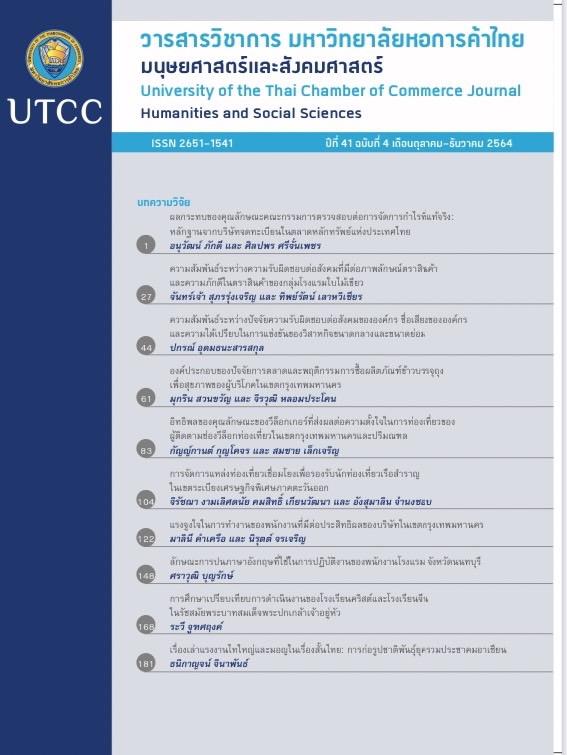The Influence of Vlogger’s Attributes on Travel Intention of Travel Vlog Followers in Bangkok Metropolitan Region
Main Article Content
Abstract
The objectives of this research were 1) to develop and validate the consistency of a causal relationship modal of followers’ travel intention on Travel Vlog in Bangkok Metropolitan Region and 2) to study the causal factors influencing followers’ travel intention on Travel Vlog in Bangkok Metropolitan Region. The tool used in the research was online questionnaires. The sample of this research consisted of 277 people who have been followed on Cultural Tourism Vlog and lived in Bangkok Metropolitan Region. The statistics used in data analysis were frequency, percentage, and structural equation modeling was used to analyze causal relationships to find the path to the causal influence of the variables consisting of 4 components including 1) Vlogger’s Attributes 2) Content Sharing Intention 3) Attitude toward Tourist Attractions 4) Travel Intention. The results of the research showed that the causal relationship model was developed in accordance with empirical data and considered by CMIN/df = 1.12, GFI = 0.93, AGFI = 0.91, CFI = 0.99, RMSEA = 0.02, SRMR = 0.03, RMR = 0.04, and the predictive coefficient = 0.85. Therefore, the variables in the model can explain the variance of followers’ travel intention on Travel Vlog by 85 percent. Attitude toward Tourist Attractions factor has the most direct influence on Travel Intention, and Vlogger’s Attributes has the most indirect influence on Travel Intention of followers on Travel Vlog.
Article Details

This work is licensed under a Creative Commons Attribution-NonCommercial-NoDerivatives 4.0 International License.
ลิขสิทธิ์ของบทความ
ผลงานที่ได้รับการตีพิมพ์ถือเป็นลิขสิทธิ์ของมหาวิทยาลัยหอการค้าไทย ห้ามมิให้นำเนื้อหา ทัศนะ หรือข้อคิดเห็นใด ๆ ของผลงานไปทำซ้ำ ดัดแปลง หรือเผยแพร่ ไม่ว่าทั้งหมดหรือบางส่วนโดยไม่ได้รับอนุญาตเป็นลายลักษณ์อักษรจากมหาวิทยาลัยหอการค้าไทยก่อน
References
กริช แรงสูงเนิน. (2554). การวิเคราะห์ปัจจัยด้วย SPSS AMOS เพื่อการวิจัย. กรุงเทพฯ: ซีเอ็ดยูเคชั่น.
กรุงเทพมหานคร, สำนักยุทธศาสตร์และประเมินผล. (2552). แผนพัฒนากรุงเทพมหานคร ระยะ 12 ปี (พ.ศ. 2552-2563) กรุงเทพฯ มหานครแห่งความน่าอยู่อย่างยั่งยืน. สืบค้นจาก http://www.bangkok.go.th/upload/user/00000301/pdf/Plan/bma_plan/12years(%202552-2563).pdf
กัญญารินทร์ วัฒนเรืองนันท์. (2558). อิทธิพลของ Beauty Influencers ที่มีต่อพฤติกรรมการซื้อเครื่องสำอางของผู้บริโภคกลุ่มวัยทำงานตอนต้น ในเขตกรุงเทพมหานครตั้งใจแนะนําร้านกาแฟสดขนาดย่อมผู้ประกอบการไทยในเขตกรุงเทพมหานคร (วิทยานิพนธ์ปริญญามหาบัณฑิต ไม่ได้ตีพิมพ์). มหาวิทยาลัยธรรมศาสตร์, กรุงเทพฯ.
ชนิสรา บัวคง. (2561). ความสัมพันธ์ของทัศนคติที่มีต่อผู้ทรงอิทธิพลทางสื่อสังคมกับความตั้งใจใช้บริการร้านอาหารหลังการดูรีวิว (สารนิพนธ์ปริญญามหาบัณฑิต ไม่ได้ตีพิมพ์). มหาวิทยาลัยศรีนครินทรวิ โรฒ, กรุงเทพฯ.
ชไมพร กาญจนกิจสกลุ. (2555). ระเบียบวิธีวิจัยทางสังคมศาสตร์. ตาก: โพรเจ็คท์ไฟฟ์-โฟว์.
ธนชาติ นุ่มนนท์. (2563, 24 กุมภาพันธ์). คนไทยใช้เวลากับอินเทอร์เน็ต สูง ‘อันดับห้า’ ของโลก.กรุงเทพธุรกิจ. สืบค้นจาก https://www.bangkokbiznews.com/news/detail/867408#:~:text=ขณะที่%20การใช้อินเทอร์เน็ต,กว่าเรา%20คือ%20แอฟริกาใต้%2C%20บราซิล
ธันต์ชนก สิทธิพันธ์. (2558). การเปิดรับสื่อและทัศนคติของผู้บริโภคที่ซื้อสินค้าออนไลน์ประเภทผลิตภัณฑ์เสริมความงามที่มีต่อการใช้บุคคลที่มีชื่อเสียงมารับรองสินค้าผ่านอินสตาแกรม (การค้นคว้าอิสระมหาบัณฑิต ไม่ได้ตีพิมพ์). มหาวิทยาลัยกรุงเทพ, ปทุมธานี.
นงลักษณ์ วิรัชชัย. (2542). โมเดลลิสเรล: สถิติวิเคราะห์สำหรับการวิจัย (พิมพ์ครั้งที่ 3). กรุงเทพฯ: โรงพิมพ์แห่งจุฬาลงกรณ์มหาวิทยาลัย.
นรินทร์ เย็นธนกรณ์. (2558). 10 วิธีการทำ Viral Video ให้ประสบความสำเร็จ. สืบค้นเมื่อ 30 ตุลาคม 2563,
จาก https://www.marketingoops.com/exclusive/case-studies-exclusive/case-study-10-how-to-viral-video- marketing/ January 29, 2015
นฤมล เพิ่มชีวิต. (2552). การแสวงหาข้อมูล การใช้ประโยชน์ และความเชื่อถือในข้อมูลการ ท่องเที่ยวจาก สื่อออนไลน์ที่ผู้บริโภคสร้างเองของคนวัยทำงาน (วิทยานิพนธ์ปริญญามหาบัณฑิต ไม่ได้ตีพิมพ์). จุฬาลงกรณ์มหาวิทยาลัย, กรุงเทพฯ.
นันทพร เขียนดวงจันทร์, และขวัญกมล ดอนขวา. (2562). ทัศนคติ และความตั้งใจที่มีอิทธิพลต่อพฤติกรรมผู้บริโภคในการซื้อสินค้าผ่านไลน์. วารสารเทคโนโลยีสุรนารี, 13(2), 31-52.
พัฒนเดช อาสาสรรพกิจ. (2559, 22 มีนาคม). ท่องเที่ยวยุคดิจิทัล. คมชัดลึก. สืบค้นจาก https://www.komchadluek.net/news/economic/224484
แพร ไกรฤกษ์. (2558). อิทธิพลของบิวตี้บล็อกเกอร์กับการบริโภคผลิตภัณฑ์เสริมความงามของสตรีไทยในยุคสื่อสังคมออนไลน์ (การค้นคว้าอิสระมหาบัณฑิต ไม่ได้ตีพิมพ์).มหาวิทยาลัยกรุงเทพ, ปทุมธานี.
แพรวไพลิน มณีขัติย์, และพรพรหม สุธาทร. (2563). อิทธิพลของรีวิวออนไลน์ที่ส่งผลต่อพฤติกรรมการวางแผนท่องเที่ยวของนักท่องเที่ยวชาวไทยกลุ่มเจเนเรชันวาย. วารสารวิทยาลัยดุสิตธานี, 14(2), 590-609.
มนตรี พิริยะกุล, และอริญชย์ ณ ระนอง. (2560). อิทธิพลของทัศนคติที่มีต่อการโฆษณาสินค้าในฐานะปัจจัยคั่นกลางที่ถ่ายทอดอิทธิพล ขององค์ประกอบของการรับรองผลิตภัณฑ์โดยบุคคลที่มีชื่อเสียงสู่ความตั้งใจซื้อ. วารสารวิชาการเครือข่ายบัณฑิตศึกษามหาวิทยาลัยราชภัฏภาคเหนือ, 7(13), 38-39.
สำนักงานสถิติแห่งชาติ. (2561). การสํารวจการมีการใช้เทคโนโลยีสารสนเทศ และการสื่อสารในครัวเรือน พ.ศ. 2561 (ไตรมาส1). สืบค้นเมื่อ 30 ตุลาคม 2563, จากhttp://www.nso.go.th/sites/2014/DocLib13/ด้านICT/เทคโนโลยีในครัวเรือน/2561/ict61-CompleteReport-Q1.pdf
สุทธาภา อมรวิวัฒน์, วิธาน เจริญผล, ปวริศร์ พฤศราช, ธันยาพร เล้าโสภาภิรมย์, ภูริพัฒน์ โสภณคีรีรัตน์, และลภัส อัครพันธุ์. (2560). 3 กระแสแรงแห่งยุค ปรับลุคธุรกิจท่องเที่ยว. สืบค้นจาก https://www.scbeic.com/th/detail/file/product/3369/eol70mpcpl/EIC_Insight_Tourism_2017_TH.pdf
สุนัน คงธงชัย. (2562). แรงจูงใจในการแชร์คุณค่าประสบการณ์และทัศนคติของผู้บริโภคที่ส่งผลต่อความตั้งใจแนะนําร้านกาแฟสดขนาดย่อมผู้ประกอบการไทยในเขตกรุงเทพมหานคร (วิทยานิพนธ์ปริญญามหาบัณฑิต ไม่ได้ตีพิมพ์). มหาวิทยาลัยกรุงเทพ, ปทุมธานี.
สุรพงษ์ โสธนะเสถียร. (2533). การสื่อสารกับสังคม. กรุงเทพฯ: โรงพิมพ์จุฬาลงกรณ์มหาวิทยาลัย.
Birch-Jensen, J. (2020). Travel vloggers as a source of information about tourist destinations. (Research project, Umeå University). Retrieved from https://www.diva-portal.org/smash/get/diva2:1438168/FULLTEXT01.pdf
Choi, W., & Lee, Y. (2019). Effects of fashion vlogger attributes on product attitude and content sharing. Fashion and Textiles, 6(6), 1-18.
Collier, A., & Harraway, S. (1997). Principler of tourism. Auckland, New Zealand: Longman.
Devineni, M. (2017). 10 Different popular types of vlogs. Retrieved October 12, 2020, from http://vloglikepro.com/10-different-popular-types-vlogs
Dietz, G., & Hartog, D. N. (2006). Measuring trust inside organizations. Personnel Review, 35(5), 557-588.
Fishbein, M., & Ajzen, I. (2010). Predicting and changing behavior: The reasoned actionapproach. New York, NY: Psychology.
Gordon, I. (1935). On new and imperfectly known species of Crustacea Macrura. Zoological Journal of the Linnean Society, 39(266), 307-351.
Hair, J., William, C. B., Barry, J. B., & Rolph, E. A. (2010). Multivariate data analysis (7th ed.). Upper Saddle River, NJ.: Prentice-Hall.
Hawkins, D. I., Best, R. J., & Coney, K. A. (1995). Consumer behavior: Building marketingstrategy (7th ed). New York, NY: McGraw-Hill.
Hoelter, D. R. (1983). The analysis of covariance structures: Goodness of fit indices. Journal of Socillogical Methods and Research, 11(3), 325-344.
Hovland, C.I., Janis, I. L., & Kelley, H. H. (1953). Communication and persuasion: psychological studies of opinion change. New Haven, CT: Yale University Press.
Kline, R. B. (2011). Principles and practice of structural equation modeling (3 rd ed.). New York, NY: The Guilford Press.
Konerding, U. (1999). Formal models for predicting behavioral intentions indichotomous choice situations. Methods of Psychological Research, 4(2), 1-32.
Lee, J. E., & Watkins, B. (2016). YouTube vloggers’ infuence on consumer luxury brand perceptions and intentions. Journal of Business Research, 69, 5753–5760.
Loureiro, S.M.C. (2014). The role of the rural tourism experience economy in place attachment and behavioral intentions. International Journal of Hospitality Management, 40,1–9.
Munar, A.M., & Jacobsen, J.K.S. (2014). Motivations for sharing tourism experiences through social media. Tourism Management, 43, 46-54.
Ohanian, R. (1990). Construction and validation of a scale to measure celebrity endorsers’ perceived expertise, trustworthiness, and attractiveness. Journal of Advertising, 19(3), 39–52.
Shaheen, M., Lodhi, R.N., Mahmood, Z., & Abid, H. (2017). Factors influencing consumers’ attitude, Intention and behavior towards short message service-based mobile advertising in Pakistan. The IUP Journal of Brand Management, 14(1), 24-44.
Yuki, M., & Brewer, M. (2014). Culture and group processes. Oxford: Oxford University.


